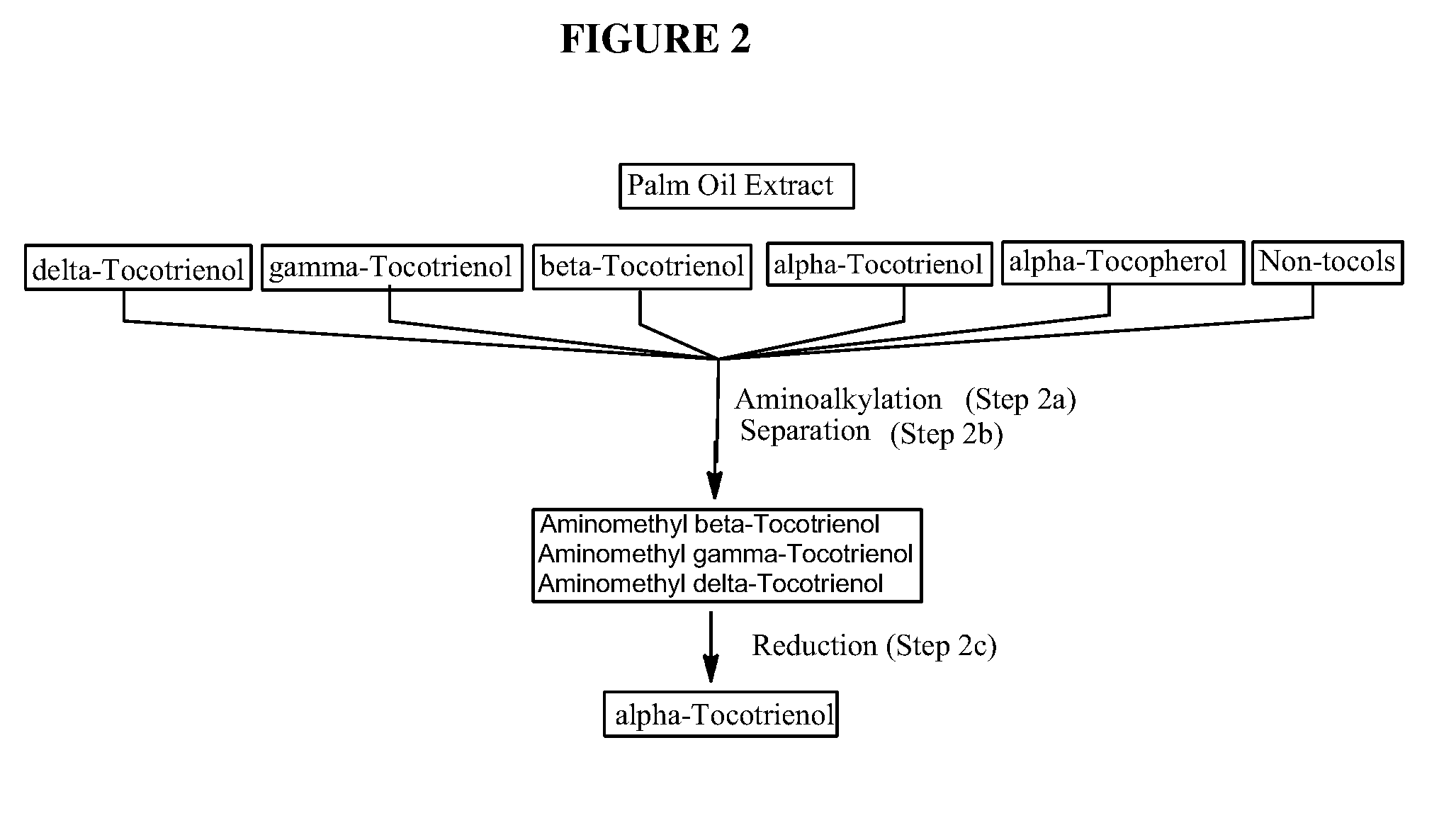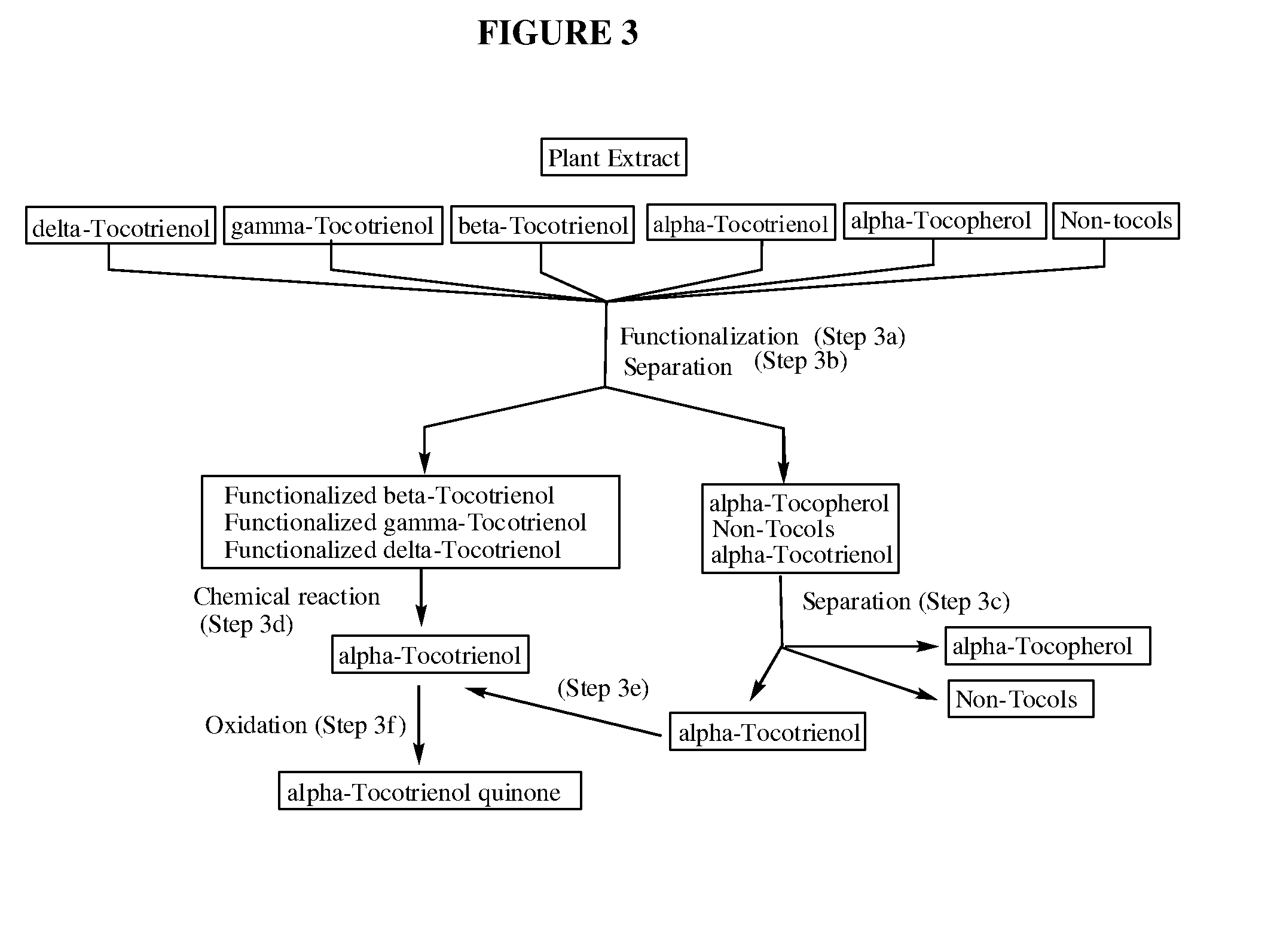Process for the production of alpha-tocotrienol and derivatives
a technology which is applied in the field of process for the production of alpha-tocotrienol and derivatives, can solve the problems of high cost, difficult synthesis of tocotrienol in the natural form, and resurgence of very expensive procedures, and achieves the effect of less intensive and/or expensive chromatography and more economical commercial process
Active Publication Date: 2012-01-31
PTC THERAPEUTICS INC
View PDF23 Cites 45 Cited by
- Summary
- Abstract
- Description
- Claims
- Application Information
AI Technical Summary
Benefits of technology
This method enables the large-scale, economically feasible production of high-purity alpha-tocotrienol, reducing the need for expensive chromatography and achieving purity levels of up to 99.9%, with minimal isomerization of double bonds.
Problems solved by technology
There is a problem inherent in obtaining tocotrienols from natural sources, in that the tocotrienol yield from such processes is a mixture of varying amounts of all of the natural tocotrienols and tocopherols.
In order to obtain a pure member of the tocotrienol family, it has been necessary to resort to very expensive procedures such as preparative scale reverse-phase chromatography or simulated moving bed chromatography.
The synthesis of tocotrienols in the natural form, having the (2R) chiral configuration and trans double bonding at the proper locations in the side chain, has also been proven to be of considerable difficulty.
While synthetic and natural tocopherols are readily available in the market, the supply of natural tocotrienols is limited, and generally comprises a mixture of tocotrienols.
Methods for isolation or enrichment of tocotrienol from certain plant oils and plant oil by-products have been described in the literature, but these methods generally produce mixtures of natural tocols in varying amounts and are not economically feasible on a commercial scale.
As mentioned above, in order to obtain a pure member of the tocotrienol family, it has been necessary to resort to expensive procedures such as preparative scale reversed-phase chromatography or simulated moving bed chromatography.
Because of the similar molecular and retention characteristics of the various individual tocopherols and tocotrienols, separation of the individual compounds has been proven difficult and not commercially viable.
Method used
the structure of the environmentally friendly knitted fabric provided by the present invention; figure 2 Flow chart of the yarn wrapping machine for environmentally friendly knitted fabrics and storage devices; image 3 Is the parameter map of the yarn covering machine
View moreImage
Smart Image Click on the blue labels to locate them in the text.
Smart ImageViewing Examples
Examples
Experimental program
Comparison scheme
Effect test
example
[0120]
General Procedures
[0121]All solvents and reagents were used as obtained from their respective suppliers except as noted. 1H and 13C NMR were obtained on a Varian Ultrashielded magnet at 400 MHz and 100 MHz respectively in deuterated solvents as noted. All spectra are referenced in ppm to either their residual solvent peak, as defined in Gottlieb, H. E. et al.; J. Org. Chem. 1997, 62, 7512-7515, or TMS at 0.00 ppm.
the structure of the environmentally friendly knitted fabric provided by the present invention; figure 2 Flow chart of the yarn wrapping machine for environmentally friendly knitted fabrics and storage devices; image 3 Is the parameter map of the yarn covering machine
Login to View More PUM
| Property | Measurement | Unit |
|---|---|---|
| temperature | aaaaa | aaaaa |
| pore size | aaaaa | aaaaa |
| temperature | aaaaa | aaaaa |
Login to View More
Abstract
The invention discloses novel processes for production, enrichment and / or isolation of alpha-tocotrienol from source material comprising at least one non-alpha-tocotrienol, such as natural extracts comprising mixed tocotrienols.
Description
CROSS-REFERENCE TO RELATED APPLICATIONS[0001]This application claims priority benefit of U.S. provisional patent application No. 61 / 197,585, filed Oct. 28, 2008. The content of that application is incorporated herein by reference in its entirety.TECHNICAL FIELD[0002]This invention relates generally to a process for production, enrichment and / or isolation of pure alpha-tocotrienol from natural extracts that comprise mixed tocols. In particular, the invention relates to a novel and effective process for production, enrichment and / or isolation of alpha-tocotrienol of high purity from plant extracts, e.g. palm oil extract such as Tocomin®, that is economically feasible on a commercial scale. The invention also relates to a process for the synthesis of alpha-tocotrienol quinone of high purity. The invention also relates to the alpha-tocotrienol-containing product produced by the process.BACKGROUND OF THE INVENTION[0003]The present invention provides a process for the production, enrichme...
Claims
the structure of the environmentally friendly knitted fabric provided by the present invention; figure 2 Flow chart of the yarn wrapping machine for environmentally friendly knitted fabrics and storage devices; image 3 Is the parameter map of the yarn covering machine
Login to View More Application Information
Patent Timeline
 Login to View More
Login to View More Patent Type & Authority Patents(United States)
IPC IPC(8): C07D311/72C07C50/06
CPCC07D311/72C07C46/02C07C50/28C07C46/06
Inventor WESSON, KIERON E.HINMAN, ANDREW W.JANKOWSKI, ORION D.
Owner PTC THERAPEUTICS INC
Features
- R&D
- Intellectual Property
- Life Sciences
- Materials
- Tech Scout
Why Patsnap Eureka
- Unparalleled Data Quality
- Higher Quality Content
- 60% Fewer Hallucinations
Social media
Patsnap Eureka Blog
Learn More Browse by: Latest US Patents, China's latest patents, Technical Efficacy Thesaurus, Application Domain, Technology Topic, Popular Technical Reports.
© 2025 PatSnap. All rights reserved.Legal|Privacy policy|Modern Slavery Act Transparency Statement|Sitemap|About US| Contact US: help@patsnap.com



